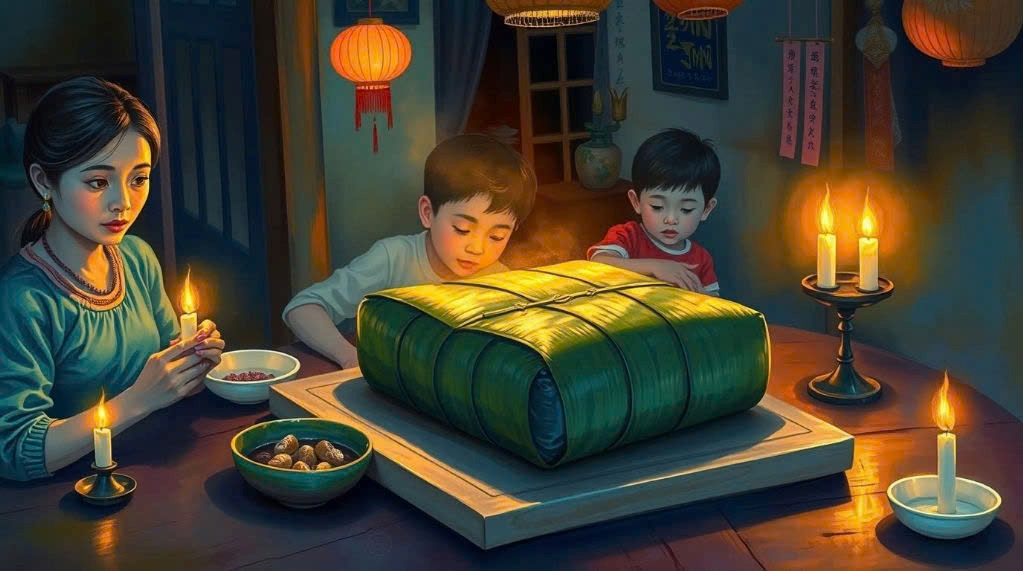Our grandparents have a saying: "Hungry on Tet, the harvest is over", meaning that when the harvest season comes, no matter how poor you are, you will have a bowl of new rice in the house; on Tet, there is no need to discuss, rich or poor, "On the 30th of Tet, meat (must) be hung in the house".
The city is different now because all food is distributed and circulated easily, so there is not much worry about shopping. However, in the countryside, up to now, families with a little extra money have prepared for Tet - Tet many months in advance, taking care of all the food for the family: children, siblings, relatives, in-laws, people eating, people working...
Especially in the important relationships during Tet, is to entertain the in-laws. There is an old saying: "In-laws are relatives of fairies"! In that party, delicious food, strange things; cooking secrets are all displayed to show respect to the "fairy relatives"; at the same time, it also contains the hidden meaning, knowing the formidable power and position of one's family so that when one's children become daughters-in-law or sons-in-law, they will not be looked down upon. In the countryside, it is not strange to see five or seven families gathering on the afternoon of the thirtieth of Tet to divide a pig, the value of this pig is not contributed immediately, it has been calculated into the work done on normal days or will be collected in the future.
“Fatty meat” is at the top of the Tet dishes. Any meat that is not offered fresh is put into a pot called “stew pot” and eaten with pickled onions (Central region radishes and pickled shallots). Pickled shallots look like onions, but smaller, with green leaves and long roots. Each bunch looks like the beard of the old man in the painting of Phuoc Loc Tho, so people use both the root and the bulb. Tet pork does not have radishes or pickled shallots, which are not much different from normal days.

Red parallel sentences also have their own role, without which the Tet atmosphere would be less fresh. Homeowners often paste red or pink paper in the form of parallel sentences with both wishes and rituals in front of the gate, in front of the door, in the kitchen and even on buffalo horns and plow handles.
The pole part, namely the flagpole, is to let the ancestors know the way back, but mainly to divide the boundary so that the evil spirits cannot invade, so that the ancestors can be at peace, and celebrate Tet from the afternoon of the 30th to the 7th day of Tet. On the pole, depending on the locality, there are things hung to ward off evil spirits. According to old books, in the North, there are also paintings of Than Tra and Uat Luy to ward off the power of the underworld; in the Central region, only houses with property and large yards have poles; the rest are mostly seen in the courtyards of village communal houses. In Hoi An, the custom of raising the pole and celebrating Tet is quite popular, and when the pole is lowered, it is understood that Tet is over, people return to their fields, shops to take care of the season, and do business.
In the past, people set off firecrackers very properly, either to ward off evil spirits or to make the ceremony more solemn when welcoming ancestors or celebrating the New Year. Only the rich, especially the Chinese, used long strings of firecrackers, sometimes "strangely" long, that exploded for hours, but that was limited to rituals. From the 60s onwards, the sound of explosions increased every day, obscuring the sky and earth, mixed with gunfire. After 1975, the explosions followed the old sounds and developed throughout the streets. Many streets seemed like war was reoccurring, with smoke billowing everywhere and no one in sight. Thousands of years of exploding firecrackers on New Year's Day only stopped in 1995, when the government strictly banned firecrackers to avoid accidents causing injuries and deaths.
Green Chung cake has gone down in history and legend since the early days of the country's founding. It has also been preserved from generation to generation in the Central and Southern regions. Green Chung cake is convenient for banquets but inconvenient for the luggage of those who travel long distances. Building this evil land did not only involve carrying a sword to open up the land and country, but almost the entire problem was hard work to preserve and develop the results.
On the way to migrate to the new land, if the square shape of the banh mau from the motherland was kept, the migrants would have difficulty carrying it far. Therefore, the square shape of banh chung was transformed into a round shape, but the ingredients of sticky rice, mung beans, and fatty meat for the filling remained unchanged. And it had a new name, banh tet, people could keep it as food for dozens of days without having to bring cutting tools: Just remove the string tied on it, put one end of the string in their teeth to bite and hold, and the other end wrapped around in a circle and "tet" strongly, and a delicious slice of cake appeared.
Quang Nam people, with their developed economy from the 17th century to the point of being influenced by Chinese customs, must have Banh To made of sticky rice flour and sugar cooked in a double boiler, placed in baskets with green banana leaves, and sprinkled with sesame seeds on top. Without Banh To, Tet is not complete, and if there is Banh Tet on the altar, there must be Banh To.
But, as mentioned above, the "principles" of celebrating Tet of our ancestors are not immutable. When the Han Dynasty's education declined, life became more materialistic, then red parallel sentences, old scholars... were gradually swept away by the dust of time. The flagpole and firecrackers are no longer familiar to the younger generation. Nowadays, young people rarely see the ancestral altar. Tet for them is a trip, an enjoyment and is becoming more and more popular.
(Article from the Central Highlands - Central Spring Labor publication 2025)













